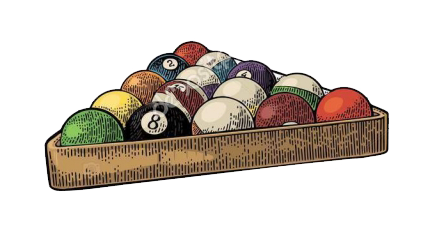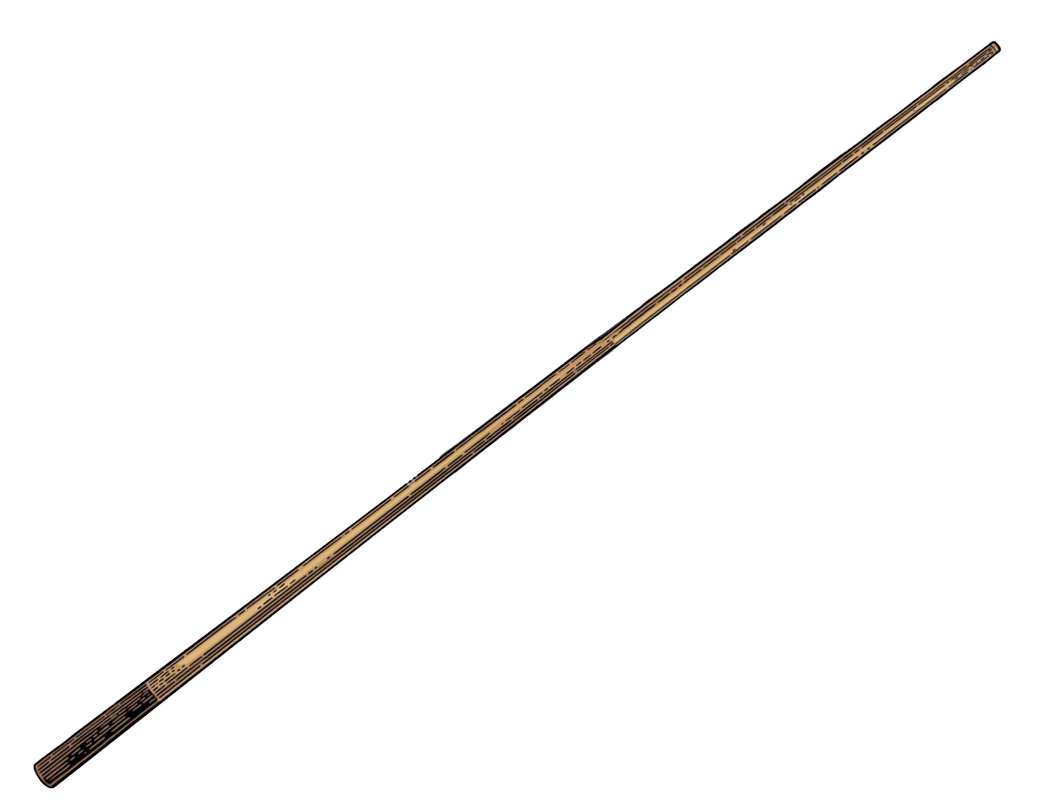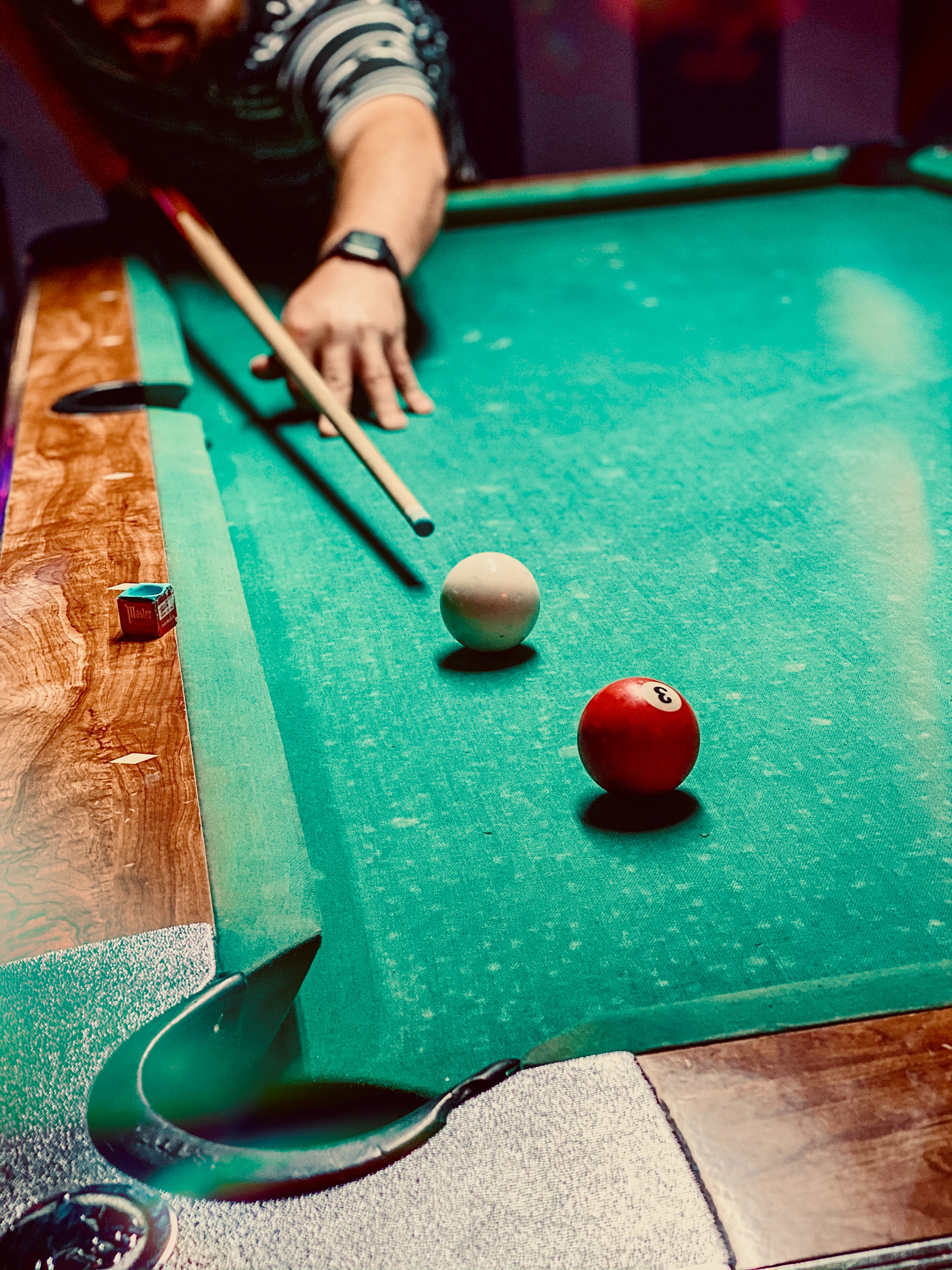Thinking about leveling up your entertainment space with a pool table, or billiard table? Or perhaps you’re in the middle of a friendly debate about pool table sizes? We totally understand. At first glance, most pool tables might seem to sport a uniform size. But, when it comes to ensuring the best gameplay and the right fit for your room, diving deep into the specifics of pool table size is crucial.
Just as with other significant home purchases, it’s essential to get the details right—and pool table size is more nuanced than you might initially think.
Pool Table Size: Classic Pool Games
7-foot tables (Bar Box): These tables, measuring 3.5 feet by 7 feet, are what you’ll typically find in bars. Primarily used for games like 8-ball, they’re excellent for casual play.
8-foot tables (Standard): A favorite for private homes, these tables measure 4 feet by 8 feet. They’re versatile, accommodating games such as 8-ball, 9-ball, and straight pool. A blend of competitive play without consuming excessive space.
9-foot tables (Tournament Size): Measuring 4.5 feet by 9 feet, these are the big leagues. Often preferred for professional 9-ball tournaments, associations like the World Pool-Billiard Association (WPA) use these for championships.
Pool Table Size: Specialized Billiard Games
Snooker: This game requires a different kind of table. Snooker tables are larger, typically spanning 12 feet by 6 feet. Unique features include smaller and more rounded pockets than standard pool tables.
Billiards or Carom: A game without pockets! Typical carom tables measure around 10 feet by 5 feet, providing a distinct challenge for players.
English Blackball or English Pool: More commonly played across the pond, this game is set on smaller tables, often around 7 feet by 4 feet, with distinctly rounded pockets.
Room Size Recommendations by Table Dimensions
| Table Size | Table Dimensions (W x L) | Ideal Minimum Room Size (W x L) |
|---|---|---|
| Mini (Child-size) | 2.5 feet x 5 feet | 12.5 feet x 15 feet |
| Small Home Size | 3 feet x 6 feet | 13 feet x 16 feet |
| Bar Box | 3.5 feet x 7 feet | 13.5 feet x 17 feet |
| Standard | 4 feet x 8 feet | 14 feet x 18 feet |
| Tournament | 4.5 feet x 9 feet | 14.5 feet x 19 feet |
| Snooker | 6 feet x 12 feet | 16 feet x 22 feet |
| Carom | 5 feet x 10 feet | 15 feet x 20 feet |
It’s important to note that these are general recommendations. The actual space you’ll need can vary based on factors like the size and type of cues you use, the presence of obstructions in the room (like support columns), and personal comfort. Always measure and evaluate your specific space and requirements before purchasing a table.
Did You Know?
Pool tables have evolved over centuries! The game originated on the lawns in the northern European countries in the 15th century. The green cloth on the table is symbolic of the grass where the game was initially played. Fascinating, right?
The Game Dynamics of Different Table Sizes
The table size shapes the player’s journey, from foundational skills to advanced techniques. While smaller tables cater to beginners and casual players, increasing the table size escalates the challenge, refining a player’s precision, strategy, and understanding of the game’s intricacies. Whether you’re just starting or aiming for professional play, there’s a table size that aligns with your goals and sharpens your skills.
Mini (Child-size) & Small Home Size Tables
- Gameplay Impact: Best suited for light, casual play or beginners, the smaller size results in shorter shots and fewer balls on the table.
- Difficulty: More forgiving, these tables offer a higher potting success rate, especially for new players or children.
- Skills Needed: Emphasizes basic aiming and cue control.
- Challenges: Their design isn’t ideal for advanced techniques, as they don’t mirror the conditions of standard-sized tables.
Related Article - Are Mini Pool Tables Worth It? A Complete Guide
7-foot (Bar Box) Tables
- Gameplay Impact: With a size larger than the mini tables, they introduce a moderate level of complexity. These are common in social settings, balancing fun and challenge.
- Difficulty: Requires better aiming and positioning, especially in games like 8-ball with many balls.
- Skills Needed: Prioritizes enhanced aiming, improved cue ball control, and initial strategic planning.
- Challenges: The more confined size can lead to clustered balls, necessitating inventive shot strategies.
8-foot (Standard) Tables
- Gameplay Impact: Often found in homes, these bridge the gap between casual play and more competitive games.
- Difficulty: They present a medium challenge, more so than the bar box, but less demanding than tournament tables.
- Skills Needed: Emphasizes improved positioning for break shots, finesse in spins and English, and strategic planning, especially for game formats like 9-ball.
- Challenges: Errors are more punishing. A misstep can lead to challenging shot sequences.
9-foot (Tournament Size) Tables
- Gameplay Impact: Designed for professional settings, these tables provide the utmost complexity and challenge.
- Difficulty: The larger play area demands utmost precision and control.
- Skills Needed: Requires mastery in cue control, advanced spin techniques, proficiency in both long and short shots, safety strategies, and overall game management.
- Challenges: The expansive size necessitates skill in long shots and maintaining superior cue ball control.
10- and 12-foot (Snooker Tables)
Snooker is played on larger tables, typically ranging from 10 to 12 feet in length.
- Gameplay Impact: The game of snooker requires strategic placement of the cue ball to score points by potting the colored balls in a specific sequence. The larger table surface, combined with smaller pockets and more balls, significantly alters the gameplay dynamics.
- Difficulty: With tighter pockets relative to the ball size and the need to navigate across a more extended surface, precision and strategy are critical.
- Skills Needed: Long potting skills, delicate touch for safety plays, mastery in controlling the white ball for break-building, and an understanding of the complex scoring system.
- Challenges: Due to the table’s length, the player often requires a “rest” (an extended cue tool) to reach shots. Also, building a high-scoring break requires foresight several shots in advance.
10-foot (Carom Billiards Tables)
Carom billiards (or three-cushion billiards) is played on pocketless tables, usually about 10 feet in length.
- Gameplay Impact: Without pockets, the objective shifts from potting balls to striking the opponent’s ball and three cushions in a single shot.
- Difficulty: Reading angles and predicting ball paths becomes the primary challenge. Each shot requires a high level of geometric foresight.
- Skills Needed: Advanced cue ball control, understanding of spins and rebounds, and the ability to “see” complex angles.
- Challenges: With no pockets, players can’t rely on potting as a bailout. Every shot demands strategic planning.
Russian Pyramid Tables
This is a game popular in countries of the former Soviet Union and is played on a table similar in size to a snooker table but with even smaller pockets.
- Gameplay Impact: The extremely tight pockets make potting balls exceptionally challenging, emphasizing precision.
- Difficulty: The game demands a higher level of accuracy than most other cue sports.
- Skills Needed: Precision aiming, solid cue action, and controlled ball striking.
- Challenges: The strict potting conditions mean that players often prioritize safety plays and defensive tactics.
The world of cue sports is diverse and offers a range of challenges depending on the game and table size. Larger tables generally require more refined skills and a deeper understanding of ball dynamics. They also often introduce unique tools, like the snooker rest or specialized cues, to aid in gameplay. As players progress and seek new challenges, exploring these different games can be both rewarding and enriching to their overall cue sports journey.
What Pool Table Size is Right For You?
Skill Level: Your current skill level and aspirations can guide your choice.
- Beginners: If you’re just starting, a smaller table might be more manageable, allowing you to hone basic skills.
- Intermediate: As you progress, an 8-foot standard table might be a good balance, offering more challenge than the 7-foot tables but not as demanding as the tournament size.
- Advanced/Pro: If you’re training for tournaments or already play at an advanced level, a 9-foot table will offer the kind of challenge you need.
Space: Beyond just the table dimensions, think about:
- Cue Action: Players need ample space to handle and angle their cues without obstructions.
- Seating and Spectators: If you plan on hosting games with multiple players or spectators, factor in seating and viewing areas.
- Accessibility: Ensure there’s enough space to walk around and access the table from all angles.
Budget:
- Initial Cost: Larger tables generally cost more, but that’s not the only price factor. The materials, brand, and craftsmanship also play roles.
- Installation: Setting up a pool table isn’t a DIY job for most. Professional installation ensures your table is level and ready for play.
- Maintenance: Pool tables need occasional maintenance, including leveling and re-felting. The costs can vary based on table size and type.
Purpose:
- Professional Setting: For those serious about the game, consider tables that match tournament specifications.
- Family Game Room: If the aim is family fun, a medium-size table may be the best fit. It’s large enough to offer a challenge but not too large for younger players.
- Decorative Piece: If the pool table is more about aesthetics, perhaps for a man cave or she shed, then the design, color, and materials might take precedence over size or playability.
Future Goals:
- Progressing Skill: If you’re passionate about improving, consider investing in a larger table from the outset, so you don’t outgrow it quickly.
- Hosting Tournaments: If you have aspirations of hosting friendly tournaments, a larger table might be beneficial.
Flexibility and Adaptability:
- Convertible Tables: Some tables can double as dining tables with a removable top. These are ideal for multipurpose rooms.
- Portability: If you’re short on space or plan to move soon, there are foldable or easily disassembled pool tables available.
Materials and Craftsmanship:
- Slate vs. Non-Slate: Slate tables offer a smoother, more professional play surface, but they’re heavier and typically more expensive.
- Table Legs and Frame: Sturdier materials ensure longevity, especially if the table will see heavy use.
- Cloth Quality: The felt’s quality can influence ball roll and game speed. High-quality wool or worsted cloth offers smoother play.
Frequently Asked Questions about Standard Pool Table Size
1. What is the standard size of a pool table?
The standard size for a pool table used in professional tournaments is 9 feet by 4.5 feet. However, other common sizes include 8 feet by 4 feet and 7 feet by 3.5 feet, particularly for home use.
2. Do different types of pool games require different table sizes?
Yes, the table size may vary depending on the specific game being played. For example, tables for snooker are generally larger than those used for 8-ball or 9-ball pool.
3. What is the standard pocket size on a pool table?
The standard corner pocket will measure between 4.5 to 4.625 inches, while the side pockets will be slightly larger.
4. How much space do I need around a pool table?
A good rule of thumb is to have at least 5 feet of space on all sides of the table. This ensures ample room for players to make shots without any hindrance.
5. Are there any official regulations for pool table sizes?
Yes, the Billiard Congress of America (BCA) has set guidelines for tournament-level pool tables, which typically measure 9 feet by 4.5 feet.
6. How do I measure my pool table?
To measure your pool table, you’ll need to measure the playing surface length and width from the inside edges of the cushions, not including the rails.
7. What are the dimensions of a bar-size pool table?
Bar-size pool tables, often referred to as “coin-operated” tables, usually measure around 7 feet by 3.5 feet.
8. How does table size affect gameplay?
A larger table will generally make the game more challenging, requiring more precision and skill. Smaller tables are generally easier and quicker to play on.
9. Is it possible to customize the size of a pool table?
Yes, many manufacturers offer customization options, although this will likely increase the overall cost of the table.
10. What materials are commonly used for pool tables?
The playing surface is usually made of slate, while the frame can be constructed from various materials such as wood, metal, or synthetic materials.





